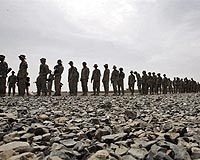| . |  |
. |
Kabul (AFP) May 10, 2009 Charges that scores of villagers died in US bombings against the Taliban have led to demands for a halt in air strikes amid warnings that civilian casualties are driving Afghans to join the insurgency. But the US and NATO forces taking on the militants say air power is an essential advantage that insurgents are trying to disable by engineering situations in which it harms civilians. Several investigations are trying to clarify what happened in the western province of Farah nearly a week ago when troops battling Taliban fighters called in the strikes. President Hamid Karzai says around 130 civilians, including children and the elderly, were killed in the bombings; a local investigation says 147 civilians died, including 94 girls. The US military concedes only that "a number" of civilians died although it is not yet clear how. The bombs hit compounds where people had taken refuge from the fighting, Granai village tribal chief Mohammad Na'eem Qader told AFP by telephone. "At that time there were no Taliban in the village," he said, adding that US President Barack Obama must "stop his military from bombing innocent people or the people will join the Taliban. This dangerous for him." Karzai meanwhile demanded an end to air strikes saying they were not an effective way of fighting terrorism but rather cause civilian casualties. Any military action that harms civilians becomes a recruiting tool for the insurgents, parliamentarian and former army general Noor-Ul Haq Ulumi told AFP. "The more you kill civilians, the more you've added to the list of your enemies. One house you destroy, one person you kill, you've added 10 to your enemies," said Ulumi, who heads parliament's defence committee. And in Afghanistan's complicated battleground where insurgents are often among ordinary people, "Using air strikes is like using an artillery shell to kill a fly," he said. "Would you bombard an American facility if a few Taliban broke into it somehow?" he asked. Ulumi said the security forces would do better to surround areas where militants were holed up and wait them out. "You don't need to kill women and children only because there are few enemy fighters hiding among them," he said. The Afghanistan Independent Human Rights Commission has long called for an expansion of ground forces and a reduction in air strikes for the same reason, commissioner Nader Nadery told AFP. Civilian casualties win support for the Taliban and play into their propaganda against the government and international forces, he said. The Farah incident "is likely to be the largest and most tragic loss of life to US bombs so far in Afghanistan," added Human Rights Watch. "Yet another devastating error inevitably calls into question the continued viability of the use of US and NATO airpower in Afghanistan," said researcher Rachel Reid. Military procedures in place to stem the civilian toll from air strikes, including verifying intelligence before launching attacks, were not working and must be reviewed, she said. The United Nations says nearly two-thirds of 828 civilians allegedly killed by pro-government forces in the conflict last year died in air strikes. Insurgents were however responsible for 55 percent of 2,118 civilian deaths in 2008, the deadliest year since the 2001 US-led invasion ousted the Taliban regime, it says. And humanitarian groups have warned that a surge of about 21,000 US troops this year will likely see more civilians caught up in the fighting. The military defends air power as one of the its main technical advantages over the Taliban. "It gives us speed, manoeuvrability and reach and it is one of the most devastating capabilities against the insurgents," said US military spokesman Colonel Greg Julian. "That is why they are focusing so much effort on creating civilian casualties in order to attempt to prevent our use of it." Brigadier General Richard Blanchette, from the NATO-led force, said air power is indispensable in saving Afghan and international troops under attack. It also provides a "significant advantage" over the Taliban where terrain impedes manoeuvre of troops and supplies or the remoteness of locations hampers the use of ground forces. However, "The insurgents can produce propaganda that would use the 'fog of war' to pretend that insurgents killed in air strikes were civilians," he said. In the western city of Herat a villager who had brought three of his wounded children to the burns unit of hospital was bitter. "We have no government, we have no one to help us," Barakat-Ullah told AFP. "We hate the Americans, I hated them before and I still hate them." Share This Article With Planet Earth
Related Links News From Across The Stans
 In Afghan 'desert of death,' a giant US military base emerges
In Afghan 'desert of death,' a giant US military base emergesCamp Leatherneck, Afghanistan (AFP) May 8, 2009 In the forbidding Afghan desert, US engineers are carving out a sprawling military camp as part of a dramatic American troop build-up designed to confront Taliban insurgents. The desolate plain in southern Helmand province that Afghans call the "desert of death" has turned into a hive of frenetic activity, underscoring President Barack Obama's decision to expand the US military commitment to ... read more |
|
| The content herein, unless otherwise known to be public domain, are Copyright 1995-2009 - SpaceDaily. AFP and UPI Wire Stories are copyright Agence France-Presse and United Press International. ESA Portal Reports are copyright European Space Agency. All NASA sourced material is public domain. Additional copyrights may apply in whole or part to other bona fide parties. Advertising does not imply endorsement,agreement or approval of any opinions, statements or information provided by SpaceDaily on any Web page published or hosted by SpaceDaily. Privacy Statement |